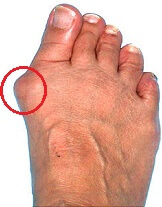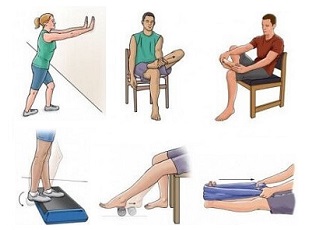- Home
- Common Foot Problems
- Bunions
- Symptoms
Bunion Symptoms
Written By: Chloe Wilson BSc(Hons) Physiotherapy
Reviewed By: FPE Medical Review Board
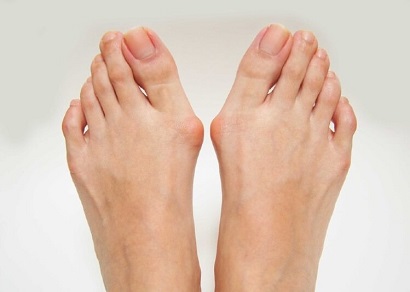
Foot bunion symptoms range from a small, painless lump on the big toe to a large deformity and severe pain that limits day-to-day activities such as walking.
Bunions develop when one of the bones in the big toe shifts out of position, causing a lump on the outer side of the toe, known as a hallux valgus or bunion.
Bunion symptoms usually develop gradually over time and get progressively worse if not treated correctly.
Bunions are typically caused by either long-term wearing of tightly fitting shoes, your genes (if your mum has bunions you are more likely to get them too) or a combination of the two.
Here we will look at the most common foot bunion symptoms as well as the prevalence of the condition. Then we will go on to look at the best treatment options available.
Common Bunion Symptoms
Bunion symptoms can vary massively from person to person. The most common foot bunion symptoms are:
1. Bony Lump
A bony lump on the side of the toe is the most classic of bunions symptoms. Swelling gradually develops on the outer side of the base of the toe which protrudes outwards.
The shape and size of the lump varies but tends to get gradually larger over time if the bunion is left untreated.
With a bunionette, the lump occurs on the little toe. A bunionette lump will be smaller than a classic bunion as the little toe is smaller.
2. Toe Pain
Toe pain is another one of the classic bunion symptoms. Often, in the early stages of foot bunions, there is little or no pain at all. However, if the toe continues to shift out of position, pain gradually increases, particularly when wearing shoes. The pain tends to fairly localised around the bunion and ball of the foot.
Weight-bearing activities such as walking are often painful with bunions which is hardly surprising when we think that a majority of our body weight goes through the bunion with each step we take. The pain from bunion symptoms may come and go or be persistent.
3. Toe Position & Foot Shape
A classic symptoms of bunions is toe deviation. As the bony lump increases in size with a bunion, the toe starts to shift inwards towards the other
toes in the foot. It may even cross over or under the next toe. This
is known as the hallux abducto valgus position. The foot may also gradually widen. Over time, the toe will deviate in further and further causing the base of the toe, and therefore the bunion, to become more prominent.
4. Redness
Redness over the bony lump is another common bunion symptoms. The redness develops when there is
repeated friction on the skin when the bony lump rubs against the edge
of a shoe. This may be one of the first bunion symptoms you experience and be more noticeable than a lump in the early stages.
5. Hardened Skin
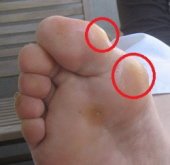
One of the later bunion symptoms is the formation of calluses. This is when the area of skin over a bunion starts to harden. This is the body trying to protect itself by laying down extra layers forming thickened, hardened skin.
Calluses themselves are usually painless and are fairly easy to treat with a combination of creams, orthotics and wide fitting shoes.
6. Toe Stiffness
Toe stiffness is another one of the later bunion symptoms to develop. You may notice that the amount of movement at your big toe becomes progressively restricted. This can be particularly obvious when you are walking. During the push-off phase of walking we push up through the big toe, pushing it back into about sixty degrees of extension. This movement often becomes painful and restricted with bunions.
In severe cases, the joint may become so stiff that there is no extension at all. When this happens, arthritis often develops at the joint, known as hallux rigidus.
How Common Are Bunions?
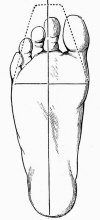
Bunion symptoms are almost ten times more likely to affect women than men. This is most likely down to narrow, tight or high heeled footwear.
They are increasingly common with aging affecting approximately 23% of adults under the age of sixty five compared to 35% of people over the age of sixty five according to an article in the Journal of Foot and Ankle research.
Bunions are much more common in countries where people wear footwear affecting approximately 30% of the western population in comparison to only 3% in non-western countries.
Bunion Treatment Options
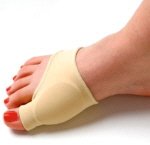
There are a number of different treatment options out there to help reduce bunion symptoms including:
- Appropriate Footwear: wide, cushioned, flat shoes are best
- Orthotics: to correct the toe position and off-load the bunion e.g. bunion pads or splints
- Medication: to control pain and inflammation
If your bunion symptoms become more severe and start affecting your daily life, you may need to have surgery.
You can find out more about the best treatment options for bunions, whatever stage you are at in the Bunion Treatment section.
What Else Can Help?
You can find out loads more about bunions in the following sections:
- Bunion Guide: An overview of bunions including common causes
- Treatment Options: Best treatments including orthotics and exercises
- Surgery: Different surgical options available
- Recovering from Surgery: Recovery guide for after surgery
- Top Products: Things that can help with prevention or recovery from surgery
Bunions are just one cause of toe pain. If these bunions symptoms aren't sounding quite like your pain, visit the toe pain diagnosis section for help working out what is causing your pain.
Page Last Updated: 11/09/23
Next Review Due: 11/09/25
